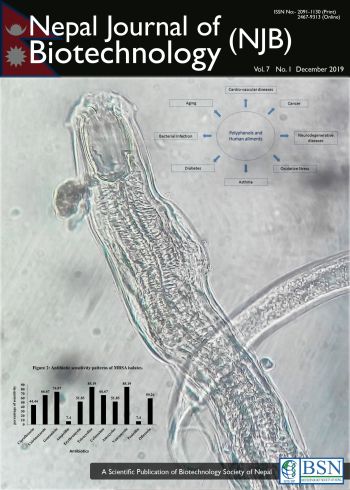Isolation, Identification and Production of Encapsulated Bradyrhizobium japonicum and Study on their Viability
DOI:
https://doi.org/10.3126/njb.v7i1.26950Keywords:
Bradyrhizobium, encapsulation, immobilization, viabiliyy, Legumes, symbiotic bacteriaAbstract
Rhizobium, a nitrogen-fixing bacteria is the essential feature of leguminous plants which is essential for the regeneration of nutrient-deficient soil. This study was aimed to isolate, identify, mass culture and immobilize Bradyrhizoium japonicum in encapsulated form and test their viability. Root nodules were sterilized, grinded and cultured aseptically in YEMA media containing Congo red. The obtained colon was sub-cultured to get a pure culture and different biochemical tests were conducted which proved Bradyrhizobium japonicum as the slow-growing species. The test shows a positive result of catalase production and nodulation test whereas the pH tolerance test shows more tolerance to the acidic pH. Similarly, Bradyrhizaobium japonicum can tolerate 1% and 2% NaCl concentration and it doesn’t show resistance to the penicillin disc of 10mg. The mass culture and encapsulation with sodium alginate adding sucrose as nutrient proved the simplicity for handling. Altogether 548 beads were prepared from the 100ml of the cultured broths which were viable for more than 190 days at 1%, 2% and 3% sucrose concentration but less viable at 5% and 10% sucrose concentration under room temperature.
Downloads
Downloads
Published
How to Cite
Issue
Section
License
Copyright Notice:
The manuscript submitted to NJB must be an original contribution, not previously published and should not be under consideration for publication elsewhere. When the manuscript is accepted for publication, the authors agree to automatically transfer the copyright of the article to the publisher. It should grant permission to any third party, in advance and in perpetuity, the right to use, reproduce or disseminate your article, according to the NJB copyright and license agreement.
Authors transfer copyright to the publisher as part of a journal publishing agreement but have the rights to: Share their article for Personal Use, Internal Institutional Use and Scholarly Sharing purposes, with the NJB applies the Creative Commons Attribution-NonCommercial CC BY-NC license to all the works we publish after Jun 2020 (Before it was CC BY-NC-ND). Under this license, authors agree to make articles legally available for reuse, without permission or fees, for virtually any non-commercial purpose. Anyone may remix, adapt, and build upon your work non-commercially, and although their new works must also acknowledge you and be non-commercial, they don’t have to license their derivative works on the same terms. More details on CC BY-NC refer to its Licence Deed and Legal Code.






